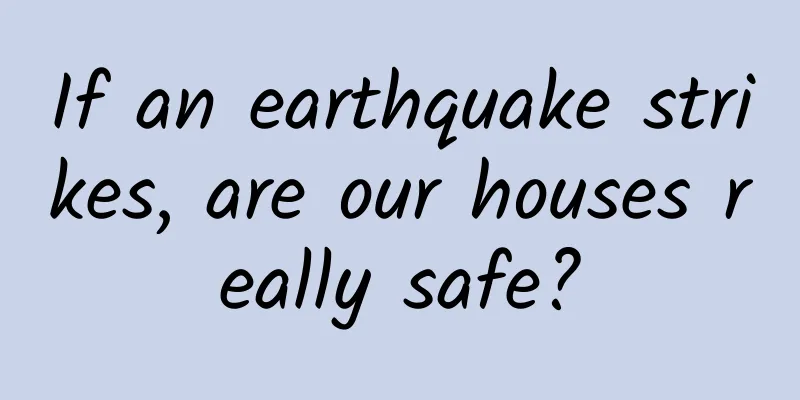If an earthquake strikes, are our houses really safe?

|
When it comes to earthquakes, everyone must be familiar with them, but do you know how earthquakes are caused? And how do they cause damage to structures such as houses and bridges? Let's discuss this issue together. Simply put, an earthquake is a vibration source generated by a change in the earth's crust, which then spreads the vibration to surrounding houses in the form of seismic waves, causing damage to houses. The cause of this vibration source may be activity between plates, volcanic eruptions, rock collapse, etc. As shown in Figure 1 below, seismic waves can be divided into three types: longitudinal waves (P waves), transverse waves (S waves) and surface waves (L waves). When the wave source is generated, these three waves will start to run like the three cars in the picture, but their forms and speeds are different when they are running. Figure 1 Diagram of seismic wave propagation The P wave is like the green car in the picture. It vibrates in the same direction as the propagation direction, has the fastest speed, and is the first to reach the ground, causing the ground to vibrate up and down, but it is less destructive. Following closely behind is the S wave represented by the red car. Its vibration direction is perpendicular to the propagation direction, causing the ground to shake left and right and front and back, which is more destructive. Finally, there is the surface wave (L wave) represented by our blue car. It is a new seismic wave generated by the P wave and the S wave on the surface. It can only propagate along the surface of the ground and is the main factor causing severe damage to buildings. Figure 2 Schematic diagram of earthquake occurrence and impact on houses Although earthquakes are terrible, not all earthquakes cause damage. According to relevant statistics, there are about 5 million earthquakes per year on average worldwide, but we can actually feel about 50,000 earthquakes, and only 100 of these earthquakes may cause damage. Next, let's take a look at the impact of the remaining 100 destructive earthquakes on houses. The following picture shows two masonry structures in Beichuan County during the 2008 Wenchuan earthquake. The two buildings are less than 50 meters apart, but the difference in damage caused is surprising? Through observation, we can see that the biggest difference between the two is the ring beam structural column. Figure 3 does not have a ring beam structural column, and the collapse is serious; while Figure 4 has a ring beam structural column, only part of the wall has X-shaped cracks, but the main structure is not damaged, and basically no harm will be caused to personnel. Figure 3 Masonry structure without ring beam structural column Figure 4 Masonry structure with ring beam and structural columns I believe everyone has the experience of packing a package in life. If a package is not wrapped with packing tape around it, it will be very loose. Similarly, the ring beam structural column in the masonry building acts as a packing tape, connecting the loose floor slab and masonry wall into a whole, which improves its earthquake resistance. In addition to the damage to masonry structures, there are also many frame structure damages at earthquake sites. Figures 5 and 6 show frame structure damages at earthquake sites. In Figure 5, the masonry filling wall in the middle of the bottom frame was sheared, forming an X-shaped crack, and in Figure 6, the columns at the corners were damaged. Figure 5 Damage to the masonry infill wall inside the frame structure Figure 6 The frame columns of the frame structure are damaged So why does such damage occur? This is where the word stiffness comes in. Stiffness refers to the ability to resist deformation. The greater the stiffness, the stronger the ability to resist deformation, but it will also bear greater earthquake effects. Whether it is the masonry infill wall in Figure 5 or the column with a half-height window sill in Figure 6, they will cause their own stiffness to increase, resulting in uneven stiffness. In this way, the greater the stiffness of the component, the more serious the damage in the earthquake. This is what people often say, "the more capable you are, the more work you will do." Since you have a high stiffness, you will bear more, but in the end you will also be the one who suffers the most. In the 9.5 Luding earthquake, the above-mentioned types of damage also reappeared to a greater or lesser extent. The figure below shows the relevant situation of the damage caused by the Luding earthquake. Figure 7 Shear failure of internal masonry infill wall Figure 8 The frame columns of the frame structure are damaged Fig. 9 Filling X-shaped cracks in walls Fig.10 The bottom floor of the frame structure collapsed We have already seen the specific forms of damage to houses in earthquakes. So, how can we reduce these earthquake damages? The most popular technology now is seismic isolation technology. Today, let us take a brief look at this mysterious secret. Seismic isolation technology refers to isolating the building structure from the ground through some seismic isolation devices, absorbing ground vibration through the deformation of the seismic isolation layer, thereby protecting the upper structure from earthquake damage. The figure below is a simple schematic diagram of the seismic isolation principle. In addition, energy dissipation and shock reduction technology is to set some non-load-bearing components of the structure (such as supports, shear walls, connectors, etc.) into energy dissipation components with strong deformation capacity, or to install energy dissipation devices in certain parts of the structure (such as between layers, nodes, etc.). Its core is to consume earthquake energy. Figure 12 Shock absorber The above-mentioned seismic isolation measures have been widely used in China. Typical seismic isolation buildings include the Lushan County People's Hospital known as the "Strong Building", the Beijing Daxing Airport Project, and the Yunnan Kunming Airport Project. Typical energy dissipation and shock absorption projects include Beijing Yingtai Center, Tianjin International Trade Center, Kunming Spring Eye, etc. Of course, there are also cases in China where these two technologies are used in combination, such as Tangshan Maternal and Child Health Hospital Project, Tancheng Vocational and Technical School, and Sichuan Xichang Panxi International Trade City, which use both seismic isolation technology and shock absorption technology. Finally, when an earthquake really strikes, are our houses really safe? I think as long as our houses have reasonable site planning, proper design theory, and standard construction technology, they can completely withstand moderate earthquakes. If seismic isolation technology is reasonably added on this basis, such houses are undoubtedly safe. END Author: Guo Yu (School of Civil Engineering and Water Conservancy, Zhejiang University of Technology) Editor: Guru |
Recommend
30 guidelines for brand marketing in the post-epidemic stage
Recently, a large number of companies have resume...
Scientists unveil Ebola virus's 'replication machine'
In September this year, the Ebola outbreak reappe...
No wonder I can’t wear a turtleneck in winter! I found the cause of my long-standing problem...
Today, #Why do some people feel uncomfortable whe...
New ASO optimization trends you must know for APP promotion in 2017!
In the final analysis, ASO is essentially about sa...
In the metaverse, will robots become humans?
At present, human technology is developing rapidl...
He made a fool of himself that year, but went on to dominate 40 years of postwar science
Richard Feynman (1918-1988). Image source: Wikipe...
Brand promotion, how to formulate a brand portfolio strategy?
What is brand portfolio strategy? It is to system...
How could such a large lake disappear just like that? Where can we find evidence of life on Mars?
In the long evolution of a planet, stones are bot...
Officials offer advice on weight loss! Your obesity has finally alarmed the nation
Central China The staple food of residents in Cen...
Apple joins Facebook's Open Computing Program to help build open hardware and data center architecture
[[129394]] The news about Apple's newly launc...
Check yourself! Come and see if your ID card has been stolen by others!
appendix: Official website of the Credit Informat...
Will VR be the future of gaming? Can virtual reality technology open up new ideas for gaming?
If you have watched the Conan the Killer Schoolbo...
Increase conversion rate by 50% in 4 steps, revealing the underlying logic of traffic acquisition!
When it comes to customer acquisition, there are ...
A 54-year-old archaeologist gave up his "professorial burden" and became a food blogger. What happened?
"People in Guangxi ate snails 20,000 years a...
6 marketing strategies that work well on the Internet and in physical stores, with 18 real cases included!
Without further ado, let’s get straight to the po...









